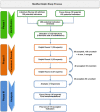Quality and capacity indicators for hospitalized pediatric oncology patients with critical illness: A modified delphi consensus
- PMID: 32777172
- PMCID: PMC7541142
- DOI: 10.1002/cam4.3351
Quality and capacity indicators for hospitalized pediatric oncology patients with critical illness: A modified delphi consensus
Abstract
Background: Hospitalized pediatric hematology-oncology (PHO) patients are at high risk for critical illness, especially in resource-limited settings. Unfortunately, there are no established quality indicators to guide institutional improvement for these patients. The objective of this study was to identify quality indicators to include in PROACTIVE (PediatRic Oncology cApaCity assessment Tool for IntensiVe carE), an assessment tool to evaluate the capacity and quality of pediatric critical care services offered to PHO patients.
Methods: A comprehensive literature review identified relevant indicators in the areas of structure, performance, and outcomes. An international focus group sorted potential indicators using the framework of domains and subdomains. A modified, three-round Delphi was conducted among 36 international experts with diverse experience in PHO and critical care in high-resource and resource-limited settings. Quality indicators were ranked on relevance and actionability via electronically distributed surveys.
Results: PROACTIVE contains 119 indicators among eight domains and 22 subdomains, with high-median importance (≥7) in both relevance and actionability, and ≥80% evaluator agreement. The top five indicators were: (a) A designated PICU area; (b) Availability of a pediatric intensivist; (c) A PHO physician as part of the primary team caring for critically ill PHO patients; (d) Trained nursing staff in pediatric critical care; and (e) Timely PICU transfer of hospitalized PHO patients requiring escalation of care.
Conclusions: PROACTIVE is a consensus-derived tool to assess the capacity and quality of pediatric onco-critical care in resource-limited settings. Future endeavors include validation of PROACTIVE by correlating the proposed indicators to clinical outcomes and its implementation to identify service delivery gaps amenable to improvement.
Keywords: clinical cancer research; pediatric cancer; translational research.
© 2020 The Authors. Cancer Medicine published by John Wiley & Sons Ltd.
Conflict of interest statement
The authors have no conflict of interests to disclose.
Figures




